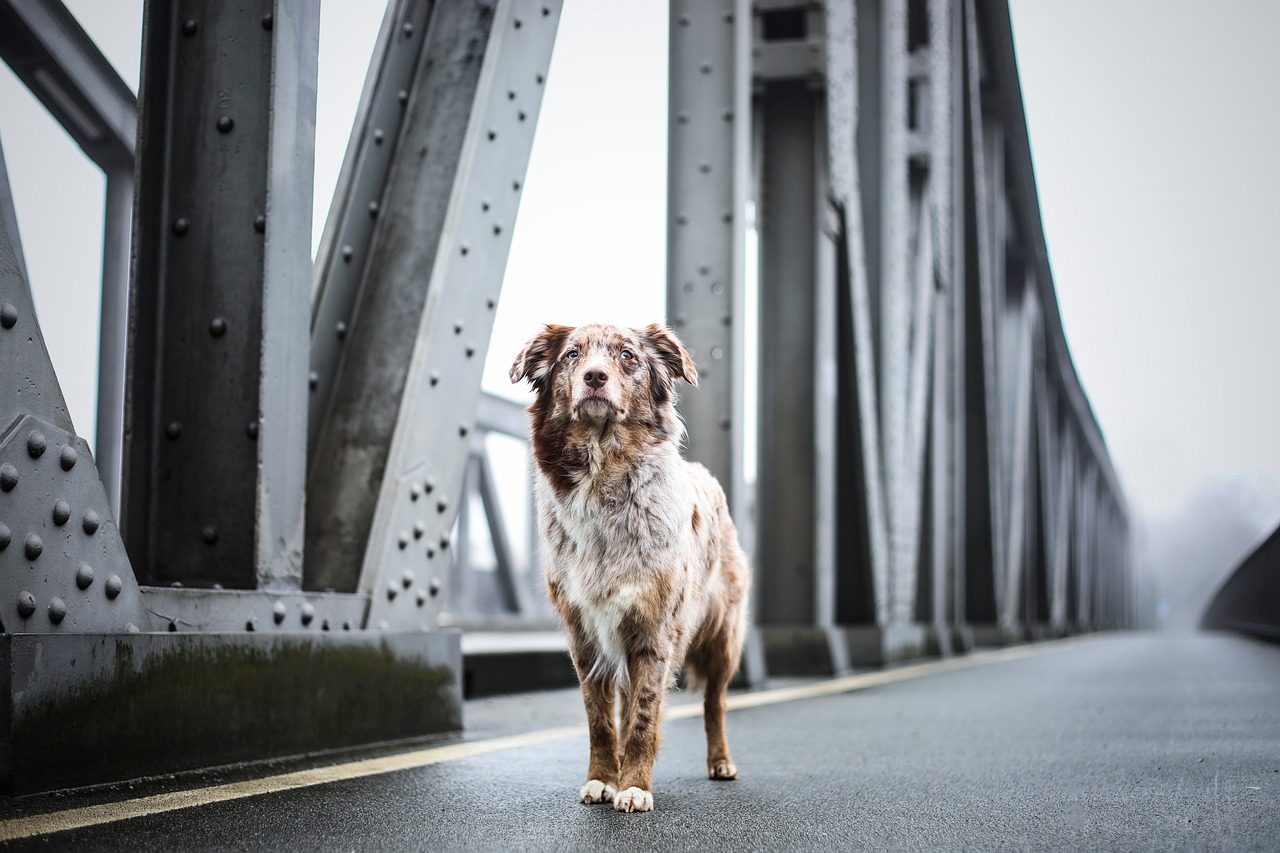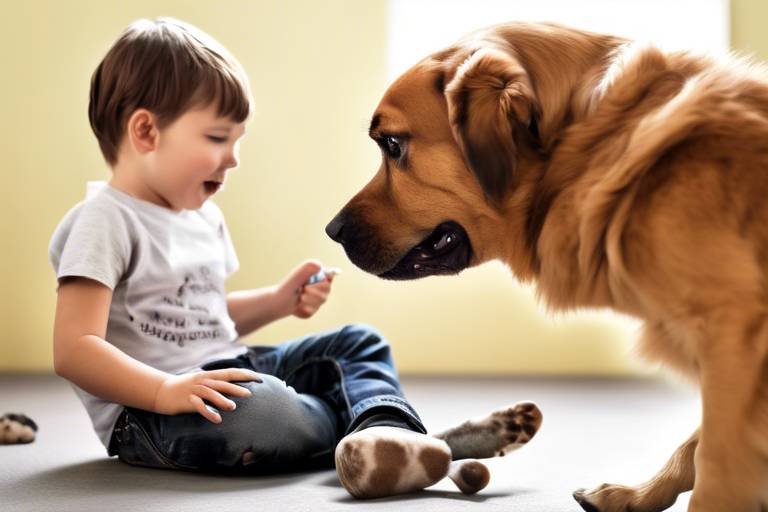How to Help Your Dog Overcome Aggression Toward Strangers
Having a dog that shows aggression toward strangers can be a challenging situation for any pet owner. It not only affects the dog's well-being but can also create anxiety for you and those around you. The good news is that with the right strategies and techniques, you can help your furry friend learn to manage their aggressive tendencies. In this article, we'll explore effective methods to reduce aggression, creating a safer and more enjoyable environment for both your pet and the public. So, if you're ready to embark on this journey of understanding and training, let's dive in!
Recognizing the root causes of aggression in dogs is crucial for effective management. Aggression can stem from various psychological and environmental factors, including fear, territorial behavior, or past trauma. For instance, a dog that has had negative experiences with strangers may react defensively when encountering new people. Understanding these underlying issues is the first step in addressing aggressive behavior. Remember, aggression is often a dog's way of communicating discomfort or fear. By learning to read your dog's body language and understanding their triggers, you can start to unravel the complexities of their behavior.
Every dog is unique, and identifying specific triggers for aggression is essential for successful intervention. Common triggers may include:
- Unfamiliar people approaching too quickly.
- People wearing hats or sunglasses.
- Children running or making loud noises.
To effectively observe your dog's behavior, spend time watching their reactions in different situations. Keep a journal to note instances of aggression, what was happening at the time, and your dog's body language. This way, you can pinpoint specific triggers and work on them systematically.
Socialization plays a vital role in a dog's behavior. Early and ongoing exposure to various people, environments, and experiences can significantly reduce the likelihood of aggressive behavior toward strangers. Think of socialization as a way to build your dog's confidence. Just like humans, dogs benefit from positive experiences with new situations. Start by introducing your dog to calm, friendly strangers in controlled environments, gradually increasing the complexity of the interactions as your dog becomes more comfortable.
Gradual exposure to different people and environments can help reduce fear and aggression. Here are some effective positive exposure techniques:
- Begin with familiar faces: Have friends or family members interact with your dog in a calm manner.
- Use treats and praise: Reinforce positive behavior with treats when your dog remains calm around new people.
- Take it slow: Gradually introduce your dog to more challenging situations, always monitoring their comfort level.
Introducing your dog to new people in a controlled manner can ease anxiety. When meeting a stranger, keep your dog on a leash and allow them to approach at their own pace. Encourage the stranger to remain calm and avoid direct eye contact, as this can be perceived as a threat. Reward your dog for calm behavior with treats and praise. This way, your dog learns that new people can be a source of positive experiences rather than fear.
Training is key to modifying aggressive behavior. Essential commands such as "sit," "stay," and "leave it" can help you manage your dog's reactions in various situations. Incorporate training sessions into your daily routine, using positive reinforcement to encourage desired behaviors. Consistency is crucial—make sure everyone in your household is on the same page regarding training techniques. Remember, training is not just about obedience; it's about building a strong bond of trust between you and your dog.
Implementing behavior modification strategies can significantly reduce aggression. Two widely-used methods are desensitization and counter-conditioning. Desensitization involves gradually exposing your dog to their triggers at a distance where they feel safe, slowly decreasing that distance over time. Counter-conditioning, on the other hand, aims to change your dog's emotional response to a trigger. For instance, if your dog reacts aggressively to strangers, you can pair their presence with something positive, like treats, to create a more favorable association.
In some cases, professional assistance may be necessary. If your dog's aggression is severe or if you're struggling to make progress, it's time to seek help from a dog trainer or behaviorist. A professional can provide tailored advice and strategies suited to your dog's specific needs, ensuring a more effective approach to managing aggression.
Tracking your dog's progress is crucial for success. Keep a detailed record of your training sessions, noting any changes in behavior. This can help you identify what works and what doesn't, allowing you to adjust your approach as needed. Celebrate small victories along the way, as every step forward is a testament to your hard work and dedication. Remember, patience is key; behavior modification takes time, and consistency will yield the best results.
1. Can aggression in dogs be completely eliminated?
While it may not be possible to completely eliminate aggressive behavior, it can often be managed and reduced significantly through training and behavior modification.
2. How long does it take to see improvements?
The timeline for improvement varies depending on the dog and the severity of the aggression. Some dogs may show changes within weeks, while others may take months.
3. Is it safe to take my aggressive dog to public places?
It's essential to assess your dog's comfort level and progress before taking them to public places. Always prioritize safety for both your dog and others.

Understanding Dog Aggression
Understanding why your dog may exhibit aggressive behavior towards strangers is the first step in addressing and managing this challenging issue. Aggression in dogs can stem from a variety of psychological and environmental factors. For instance, fear is a common trigger; a dog that feels threatened by unfamiliar people may resort to aggression as a defense mechanism. This response is often rooted in a lack of socialization or negative past experiences with strangers.
Moreover, certain breeds may be more predisposed to aggression due to their genetic makeup, but it's essential to remember that each dog is an individual. Their past experiences, training, and socialization play a significant role in shaping their behavior. For example, a dog that has been poorly socialized during its critical development stages may perceive strangers as threats, leading to aggressive reactions.
Environmental factors also contribute to a dog's aggressive tendencies. A chaotic home environment, lack of routine, or exposure to aggressive behavior from other animals or humans can heighten a dog's anxiety and lead to aggression. Additionally, if a dog feels its territory is being invaded, it may respond aggressively to protect its home. Understanding these underlying causes can help you approach the situation with empathy and patience.
It's also worth noting that aggression can manifest in various forms, including:
- Fear-based aggression: Triggered by fear of unfamiliar people or situations.
- Protective aggression: A dog may act aggressively to protect its owner or territory.
- Frustration aggression: Occurs when a dog is restrained and unable to reach what it perceives as a threat.
By identifying the root causes of your dog's aggression, you can develop a more effective strategy for managing their behavior. This understanding will not only help you create a safer environment for your dog and others but also foster a stronger bond between you and your furry friend. Remember, aggression is often a sign of underlying issues, and addressing these with care and knowledge is crucial for long-term success.

Identifying Triggers
Understanding what makes your dog tick is essential when it comes to managing aggression towards strangers. Every dog is different, and identifying specific triggers for aggressive behavior can feel like piecing together a puzzle. For some dogs, it might be the sudden movement of a person, while for others, it could be the unfamiliar scent of a stranger. Paying attention to these nuances is crucial. So, how do you go about pinpointing these triggers?
First off, observe your dog in various situations. Take note of their body language and reactions when encountering new people. Are they barking, growling, or showing signs of stress like a tucked tail or raised hackles? Keeping a journal can be immensely helpful. You can create a simple table to track your dog's reactions:
| Date | Situation | Dog's Reaction | Notes |
|---|---|---|---|
| 01/01/2023 | Encounter with jogger | Barking, lunging | Seemed scared |
| 01/05/2023 | Visitor at home | Growling | Stiff body posture |
In addition to observing reactions, consider the context in which these behaviors occur. Is your dog more aggressive when they are on a leash? Or perhaps when they are in a confined space? These environmental factors can play a significant role in your dog's aggression. By identifying patterns in their behavior, you can start to understand what triggers their aggression. This understanding can lead to more effective training and behavior modification strategies.
Another important aspect to consider is the type of people that may trigger your dog's aggression. Dogs often react differently to various characteristics, such as:
- People wearing hats or sunglasses
- Individuals with high-pitched voices
- Children running or playing
By recognizing these specific triggers, you can work on desensitizing your dog to these stimuli gradually. Remember, it's not just about the people themselves but also their actions and how they present themselves to your dog. The goal is to help your dog feel safe and secure, reducing their need to react aggressively.
Finally, don’t hesitate to involve your friends or family in this process. Invite them over to help with controlled introductions. By exposing your dog to a variety of individuals in a safe environment, you can better understand their triggers and work on addressing them. This way, you not only gather more data about your dog's behavior but also create a support system for your training efforts.
The Role of Socialization
Socialization is like the foundation of a house; without it, everything else can crumble. When it comes to our furry friends, socialization is incredibly important in shaping their behavior and reactions to the world around them. Just like humans, dogs thrive on interactions with different people, animals, and environments. If a dog is not properly socialized, it may develop fears and anxieties that can manifest as aggression toward strangers. Think of socialization as the doggie equivalent of a classroom where they learn the rules of engagement with the outside world.
From a young age, puppies are like sponges, absorbing everything around them. Early socialization—typically between the ages of 3 and 14 weeks—is crucial. During this window, exposing your puppy to a variety of situations, sounds, and people can help them grow into well-adjusted adults. However, socialization doesn’t stop once your dog reaches adulthood; it’s a lifelong process. Regular exposure to new experiences can keep your dog’s social skills sharp.
Consider these key aspects of socialization:
- Positive Experiences: Ensure that your dog's interactions are positive. A bad experience can lead to long-lasting fear or aggression.
- Diverse Environments: Take your dog to different environments—parks, busy streets, and even pet-friendly stores. This helps them adapt to various stimuli.
- Controlled Interactions: Gradually introduce your dog to new people and animals in a controlled manner to avoid overwhelming them.
Moreover, the benefits of socialization extend beyond just reducing aggression. A well-socialized dog is often more confident, less anxious, and better behaved. They’re less likely to bark at strangers or react negatively to unexpected situations. Imagine a dog that can accompany you to a friend’s house without turning into a ball of nerves; that’s the power of socialization!
In summary, socialization is not merely a phase in a dog’s life but an ongoing journey. By prioritizing socialization, you’re not only helping your dog to be more comfortable with strangers but also enriching their life and yours. Remember, a happy dog makes for a happy owner!
Positive Exposure Techniques
When it comes to helping your dog overcome aggression towards strangers, can be a game-changer. Think of it as introducing your dog to the world in a way that makes them feel safe and comfortable. Just like humans, dogs can become anxious or fearful when faced with new experiences, especially if they have had negative encounters in the past. By gradually exposing your dog to various people and environments, you can help them build confidence and reduce their aggressive tendencies.
One effective method is to start with controlled environments. This means finding a quiet park or a low-traffic area where you can introduce your dog to strangers without overwhelming them. Begin by having a friend or family member approach at a distance. If your dog remains calm, reward them with treats or praise. This positive reinforcement helps them associate the presence of strangers with good things, making them less likely to react aggressively.
Another technique is to use desensitization. This involves exposing your dog to the presence of strangers gradually. Start with people at a distance where your dog feels comfortable. Over time, as your dog becomes more relaxed, you can decrease the distance. For example, you might start with someone standing 20 feet away and gradually work your way closer. Remember, patience is key here; rushing the process can lead to setbacks.
Incorporating counter-conditioning can also be incredibly beneficial. This technique involves changing your dog's emotional response to a stranger. For instance, if your dog typically reacts aggressively when someone approaches, you can counter that behavior by providing treats or engaging them with a favorite toy whenever they see a stranger. Over time, your dog will begin to associate the sight of new people with positive experiences, which can significantly reduce their aggressive tendencies.
It's important to note that consistency is crucial when implementing these techniques. Regularly practicing positive exposure can help reinforce the desired behaviors. Keep sessions short and fun, and always end on a positive note. This way, your dog will look forward to these interactions rather than dread them.
In addition to these techniques, consider incorporating socialization classes or group training sessions. These environments provide controlled exposure to other dogs and people, allowing your dog to learn appropriate behaviors in a supportive setting. Plus, it’s a great way for you to connect with other dog owners and share experiences.
In summary, positive exposure techniques are essential for helping your dog overcome aggression towards strangers. By gradually introducing them to new experiences and reinforcing calm behavior with rewards, you can pave the way for a more relaxed and sociable pet.
- How long does it take to see results?
Results can vary depending on the dog and the severity of the aggression. Consistency and patience are key; some dogs may show improvement within weeks, while others may take months. - Can I use treats to help with aggression?
Yes! Treats can be a powerful tool for positive reinforcement. Just ensure they're healthy and appropriate for your dog. - Should I avoid all strangers until my dog improves?
Not necessarily. Controlled exposure to strangers can be beneficial. It's all about managing the environment and ensuring your dog feels safe.
Controlled Introductions
When it comes to helping your dog overcome aggression towards strangers, are an essential part of the process. Think of it as setting the stage for a play where each actor has a defined role. The goal here is to create a safe and structured environment that allows your dog to interact with new people without feeling threatened or overwhelmed. This method not only helps your dog feel more secure but also enables you to manage the situation effectively.
Start by selecting a calm and quiet location for the introduction. A park or a friend's backyard can be perfect, as long as it’s free from distractions. You want your dog to focus on the task at hand—meeting someone new. Before the introduction, ensure your dog is on a leash, and consider using a harness for better control. This way, you can gently guide your dog if they become anxious or agitated.
Next, choose a person who is calm and patient. Ideally, this person should have experience with dogs and understand how to approach them slowly. The key is to let your dog take the lead. Allow your dog to observe the new person from a distance, giving them time to assess the situation. It’s like letting your dog read the room before diving into a conversation. If your dog seems relaxed, you can gradually decrease the distance.
During this introduction, it’s crucial to maintain a positive atmosphere. Use treats and praise to reward your dog for calm behavior. For instance, if your dog remains relaxed while the stranger is nearby, shower them with affection and a tasty treat. This creates a positive association with the presence of new people. On the flip side, if your dog shows signs of aggression or fear, calmly remove them from the situation and try again later. Remember, patience is key! It's all about building trust and confidence.
As you progress, you can introduce more complex scenarios, such as having the stranger offer treats or engage in play. This gradual exposure helps your dog learn that strangers can be friendly and non-threatening. Keep in mind that every dog is different, and what works for one may not work for another. Be mindful of your dog's body language, and always prioritize their comfort and safety.
To summarize, controlled introductions can be a game-changer in reducing your dog’s aggression towards strangers. Here’s a quick recap of the steps to follow:
- Choose a calm, distraction-free environment.
- Use a leash and harness for better control.
- Allow your dog to observe from a distance.
- Reward calm behavior with treats and praise.
- Gradually decrease the distance as comfort grows.
- Introduce more complex interactions slowly.
By following these steps, you can create a positive experience for your dog and help them learn to trust new people. Remember, the journey to overcoming aggression takes time, but with controlled introductions, you’re well on your way to fostering a more relaxed and sociable pup!
Q: How long should controlled introductions take?
A: The duration varies based on your dog's comfort level. Start slow and allow your dog to dictate the pace. It could take a few minutes to several sessions before they feel comfortable.
Q: What if my dog reacts aggressively during an introduction?
A: If your dog shows signs of aggression, calmly remove them from the situation. It's essential not to punish them but to recognize their discomfort and try again later.
Q: Can I use controlled introductions with all types of dogs?
A: Yes, controlled introductions can be beneficial for most dogs, but always consider their individual temperament and past experiences. Some dogs may require more time and patience than others.
Q: How often should I practice controlled introductions?
A: Regular practice is beneficial, but ensure each session is positive and not overwhelming. Aim for a few times a week, adjusting based on your dog's progress.
Training and Commands
Training your dog is not just about teaching them to sit or fetch; it's about building a strong bond and establishing trust between you and your furry friend. When it comes to managing aggression towards strangers, effective training and commands are essential. Think of training as a toolbox: the more tools you have, the better equipped you are to handle various situations. One of the most critical commands to teach your dog is "Leave It." This command can be invaluable when encountering unfamiliar people, allowing you to redirect your dog's focus away from potential triggers.
Another vital command is "Sit." Teaching your dog to sit on command can help create a calm demeanor in stressful situations. When your dog is sitting, they are less likely to act out aggressively. Start by practicing this command in a quiet environment, gradually introducing distractions like strangers walking by. Consistency is key! Use positive reinforcement, such as treats or praise, to reward your dog when they successfully follow the command.
Additionally, the command "Come" is crucial for ensuring your dog's safety. If your dog feels threatened or anxious around strangers, calling them to you can help prevent aggressive behavior. Practice this command in a controlled setting, gradually increasing the level of distraction as your dog becomes more reliable. Remember, the goal is to create a positive association with the command, so always reward them when they respond correctly.
Utilizing clicker training can also enhance your dog's learning experience. This method involves using a clicker to mark desired behaviors, followed by a treat. It's a clear and effective way to communicate with your dog, helping them understand which behaviors are acceptable. For instance, if your dog remains calm when a stranger approaches, click and reward them immediately. Over time, they'll learn that calm behavior leads to positive outcomes.
Incorporating desensitization techniques during training can also be beneficial. This involves gradually exposing your dog to strangers at a distance where they feel comfortable, rewarding them for calm behavior. As they grow more accustomed to the presence of unfamiliar people, you can slowly decrease the distance. This method helps to build your dog's confidence and reduces their fear and aggression over time.
Lastly, don't underestimate the power of socialization. Regularly exposing your dog to a variety of people, environments, and experiences can significantly reduce their fear of strangers. Take your dog to dog parks, pet-friendly events, or simply stroll through busy streets. The more positive experiences they have with different people, the less likely they are to react aggressively. Remember, the journey to a well-behaved dog is a marathon, not a sprint. Be patient, consistent, and always celebrate the small victories!
- What should I do if my dog shows aggression towards strangers?
Start by identifying triggers and implementing training commands. Gradual exposure and positive reinforcement can help modify their behavior. - How long does it take to train a dog to stop aggression?
Every dog is different, and the timeline can vary. Consistent training and patience are key; some dogs may improve in weeks, while others might take months. - When should I seek professional help for my dog's aggression?
If your dog's aggression escalates or if you feel unsafe, it's crucial to consult a professional dog trainer or behaviorist.

Behavior Modification Strategies
When it comes to helping your furry friend overcome aggression, are your best allies. These techniques aim to change your dog's emotional response to strangers, transforming fear and anxiety into calmness and confidence. Think of it as teaching your dog a new way to view the world—a world that isn’t filled with threats, but with opportunities for friendship and fun.
One of the most effective methods in behavior modification is desensitization. This technique involves gradually exposing your dog to the presence of strangers in a controlled manner. Imagine introducing your dog to a new experience like slowly revealing a new toy. At first, they might be hesitant, but with time and positive reinforcement, they learn that it’s not something to fear. Start at a distance where your dog feels safe and gradually decrease that distance over time, always rewarding calm behavior with treats or praise.
Alongside desensitization, counter-conditioning plays a crucial role in changing your dog's emotional response. This technique pairs the presence of a stranger with something your dog loves, such as treats or playtime. For instance, every time your dog sees a new person, offer them their favorite snack. Over time, they’ll begin to associate strangers with positive experiences, making them less likely to react aggressively. It’s like turning a scary movie into a comedy—suddenly, the tension is gone!
To effectively implement these strategies, consistency is key. You’ll want to create a structured plan that outlines when and how you’ll practice these techniques. Here’s a simple behavior modification plan you can follow:
| Week | Activity | Goal |
|---|---|---|
| 1 | Observe and identify triggers | Understand what causes aggression |
| 2 | Start desensitization from a distance | Reduce fear response |
| 3 | Introduce counter-conditioning with treats | Create positive associations |
| 4 | Gradually decrease distance to strangers | Build confidence |
As you embark on this journey, remember that patience is essential. Just like humans, dogs have their own pace when it comes to learning and adapting. Celebrate small victories along the way, and don’t be discouraged by setbacks. If your dog shows signs of stress or fear, take a step back and give them time to acclimate.
In some cases, you may find that your efforts aren’t yielding the desired results. This is when seeking professional help can make a significant difference. A certified dog trainer or behaviorist can provide tailored strategies and support, ensuring that you and your dog are on the right path. They can also help identify any underlying issues that may be contributing to your dog's aggression.
Finally, don’t forget to monitor your dog’s progress. Keeping a journal of your dog’s behavior can help you spot patterns and track improvements. This documentation not only serves as a motivational tool but also helps you adjust your training methods as needed. Remember, every dog is unique, and what works for one might not work for another.
In conclusion, behavior modification strategies can be incredibly effective in reducing aggression toward strangers. By employing desensitization and counter-conditioning techniques, maintaining consistency, and possibly seeking professional help, you can create a safer and more enjoyable environment for both your dog and the people around you. Your dog deserves to feel secure and happy, and with your guidance, they can learn to embrace the world with open paws!
- How long does it take to see results from behavior modification? Results can vary based on the individual dog and the consistency of training, but many owners start seeing improvements within a few weeks.
- Can all dogs be rehabilitated? Most dogs can learn to manage their aggression with the right approach, though some may require professional assistance.
- Is it safe to use treats for training? Yes, using treats is a positive reinforcement method that encourages good behavior, but ensure they are healthy and suitable for your dog.
Professional Help
Sometimes, despite our best efforts, our furry friends may still struggle with aggression towards strangers. This can be a challenging situation, not just for the dog, but for the owner as well. If you've tried various techniques and haven't seen the progress you hoped for, it might be time to consider seeking . Dog trainers and behaviorists are trained to assess and address these issues with a tailored approach that suits your dog's specific needs.
When looking for a professional, it’s essential to choose someone who uses positive reinforcement methods rather than harsh techniques. Positive reinforcement encourages good behavior by rewarding your dog for desirable actions rather than punishing them for undesirable ones. This method builds trust and strengthens the bond between you and your pet, making it easier for them to learn.
Here are some factors to consider when seeking professional help:
- Qualifications: Look for trainers who are certified by recognized organizations. This ensures they have the necessary knowledge and skills to help your dog.
- Experience: A trainer with experience in dealing with aggressive behaviors will be more equipped to handle your dog's specific issues.
- Training Philosophy: Ensure their training methods align with your values. Positive reinforcement should be a cornerstone of their approach.
- References: Ask for testimonials or references from other dog owners who have successfully worked with the trainer.
Once you find a suitable trainer, they will likely conduct an initial assessment to understand your dog's behavior. This assessment may include observing your dog in various situations, discussing your dog's history, and identifying potential triggers for their aggression. Based on this information, the trainer will develop a customized training plan that may include:
| Training Method | Description |
|---|---|
| Desensitization | Gradually exposing your dog to their triggers in a controlled environment to reduce their fear response. |
| Counter-conditioning | Changing your dog's emotional response to a trigger by pairing it with something positive, like treats or praise. |
| Behavior Modification | Implementing consistent commands and routines to help your dog learn appropriate responses to strangers. |
Remember, seeking professional help is not a sign of failure; rather, it's a proactive step towards ensuring a safe and happy environment for both your dog and those around you. With the right guidance and commitment, you can help your dog overcome their aggression and enjoy a more fulfilling life.
Monitoring Progress
Monitoring your dog's progress in overcoming aggression towards strangers is not just a good practice; it's essential for ensuring that the techniques you're using are effective. Much like a personal trainer keeps track of your fitness journey, you need to keep tabs on your dog's behavioral changes. This process involves a keen eye, patience, and sometimes a bit of creativity. So, how do you go about it? Let’s break it down.
First off, it's important to establish a baseline. Before you start any training or exposure techniques, take some time to observe your dog's behavior in various situations. Note down how they react to strangers at a distance, up close, and in different environments. This can be as simple as jotting down notes in a notebook or using a smartphone app designed for tracking pet behavior. Here’s a quick table to help you set up your observations:
| Date | Situation | Distance from Stranger | Reaction | Notes |
|---|---|---|---|---|
| 01/01/2023 | Walk in the park | 20 feet | Barked | Seemed anxious |
| 01/08/2023 | Grocery store | 10 feet | Growled | Stiff body language |
| 01/15/2023 | Friend's house | 5 feet | Calm | Wagged tail |
As you implement different training and exposure techniques, keep revisiting this baseline. Look for patterns or changes in your dog's behavior. Are they becoming less reactive over time? Are they able to stay calm in situations that previously triggered aggression? These signs of progress, no matter how small, should be celebrated. Remember, progress may not always be linear; some days will be better than others, and that’s perfectly normal.
Another effective way to monitor progress is through video recordings. Capturing your dog's behavior on video can provide you with a clear visual representation of their reactions over time. You might be surprised to see how far they've come when you compare videos taken weeks apart. Just like seeing before-and-after photos can motivate someone on a weight loss journey, seeing your dog's progress can be incredibly encouraging.
Additionally, consider keeping a journal where you can reflect on your training sessions. Write down what techniques you tried, what worked, what didn’t, and how your dog responded. This not only helps you track progress but also allows you to adjust your strategies as needed. If you notice that a particular approach is yielding positive results, you can double down on that technique. Conversely, if something isn’t working, it’s time to pivot.
Finally, don’t hesitate to share your observations with a professional trainer or behaviorist. They can provide valuable insights and help you interpret the changes you’re seeing. Sometimes, an outside perspective can make all the difference in understanding your dog's behavior. Remember, the journey to overcoming aggression is a marathon, not a sprint. Celebrate the small victories, stay consistent, and always strive for a better understanding of your furry friend.
- How long does it take to see progress? - Every dog is different, but with consistent training and monitoring, you may start to see improvements within a few weeks.
- What should I do if my dog regresses? - Regression is normal. Go back to basics and reassess your approach. Sometimes, taking a step back can help.
- When should I seek professional help? - If your dog's aggression is severe or if you're feeling overwhelmed, it’s best to consult a professional trainer or behaviorist.
Frequently Asked Questions
- What causes aggression in dogs towards strangers?
Aggression in dogs can stem from various factors, including fear, lack of socialization, territorial instincts, or past negative experiences. Understanding the underlying cause is essential for addressing the behavior effectively.
- How can I identify my dog's triggers for aggression?
To identify triggers, observe your dog's reactions in different situations. Take note of the specific people, environments, or sounds that cause your dog to react aggressively. Keeping a journal of these observations can help you pinpoint patterns and triggers.
- What role does socialization play in preventing aggression?
Socialization is crucial for dogs, especially during their formative months. Exposing your dog to various people, environments, and experiences helps them become more comfortable and confident, reducing the likelihood of aggressive behavior towards strangers.
- What are some effective positive exposure techniques?
Positive exposure techniques involve gradually introducing your dog to new people and situations in a controlled manner. Start from a distance where your dog feels safe and reward calm behavior with treats or praise. Slowly decrease the distance as your dog becomes more comfortable.
- How should I conduct controlled introductions with my dog?
For controlled introductions, ensure your dog is on a leash and in a comfortable environment. Have the new person approach slowly and calmly, allowing your dog to sniff and observe at their own pace. Always reward positive interactions to reinforce good behavior.
- What training commands are essential for managing aggression?
Essential commands include "sit," "stay," and "leave it." These commands can help redirect your dog's focus and provide you with better control in situations that may trigger aggression. Consistent training is key to reinforcing these commands.
- When should I seek professional help for my dog's aggression?
If your dog's aggression is severe, persistent, or poses a danger to others, it's crucial to seek professional help. A certified dog trainer or behaviorist can provide tailored strategies and support to address the issue safely and effectively.
- How can I monitor my dog's progress in overcoming aggression?
Monitoring progress involves keeping track of your dog's behavior over time. Note any improvements or setbacks in a journal, and adjust your training techniques as needed. Regularly assessing your dog's reactions will help you determine the effectiveness of your approach.



















